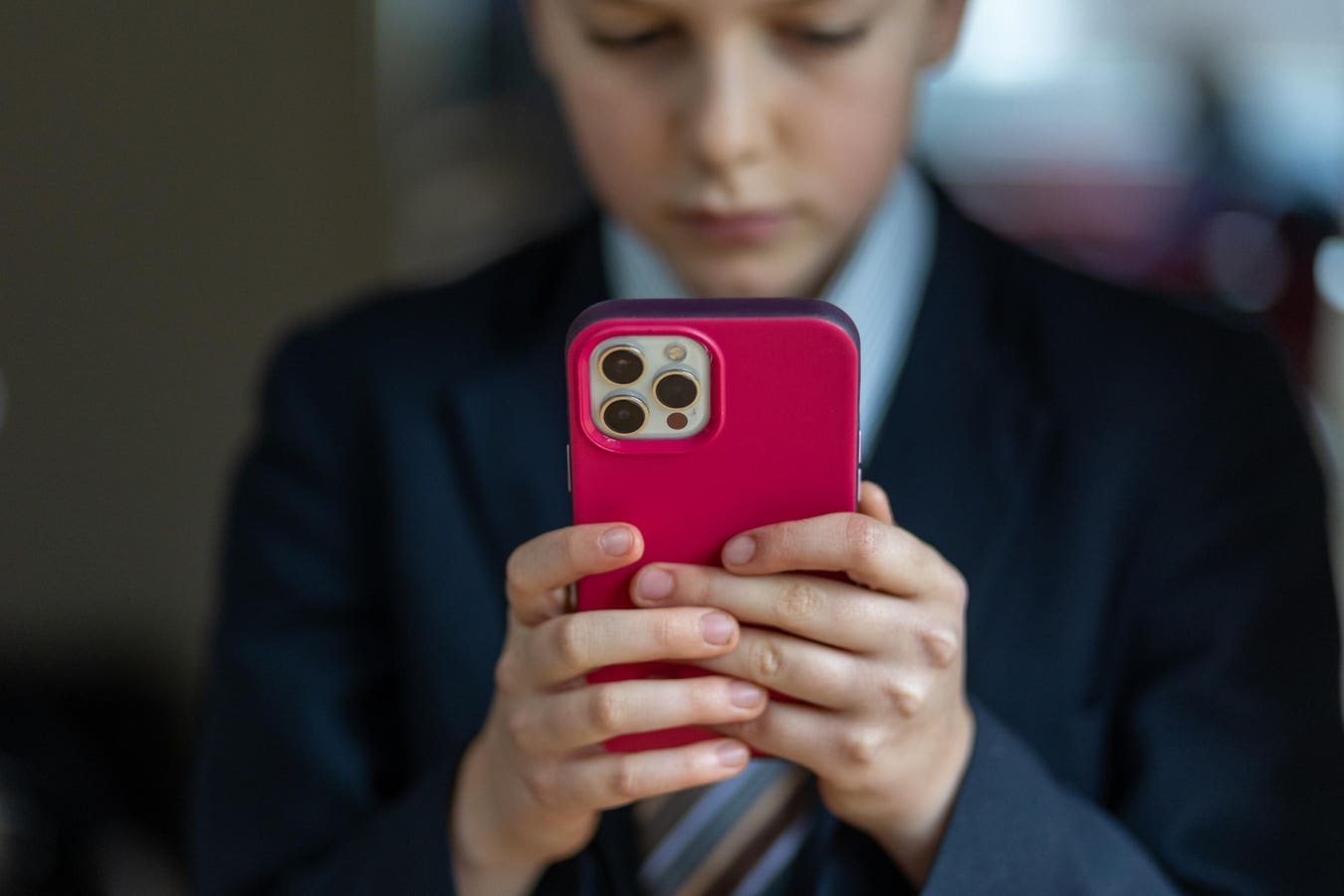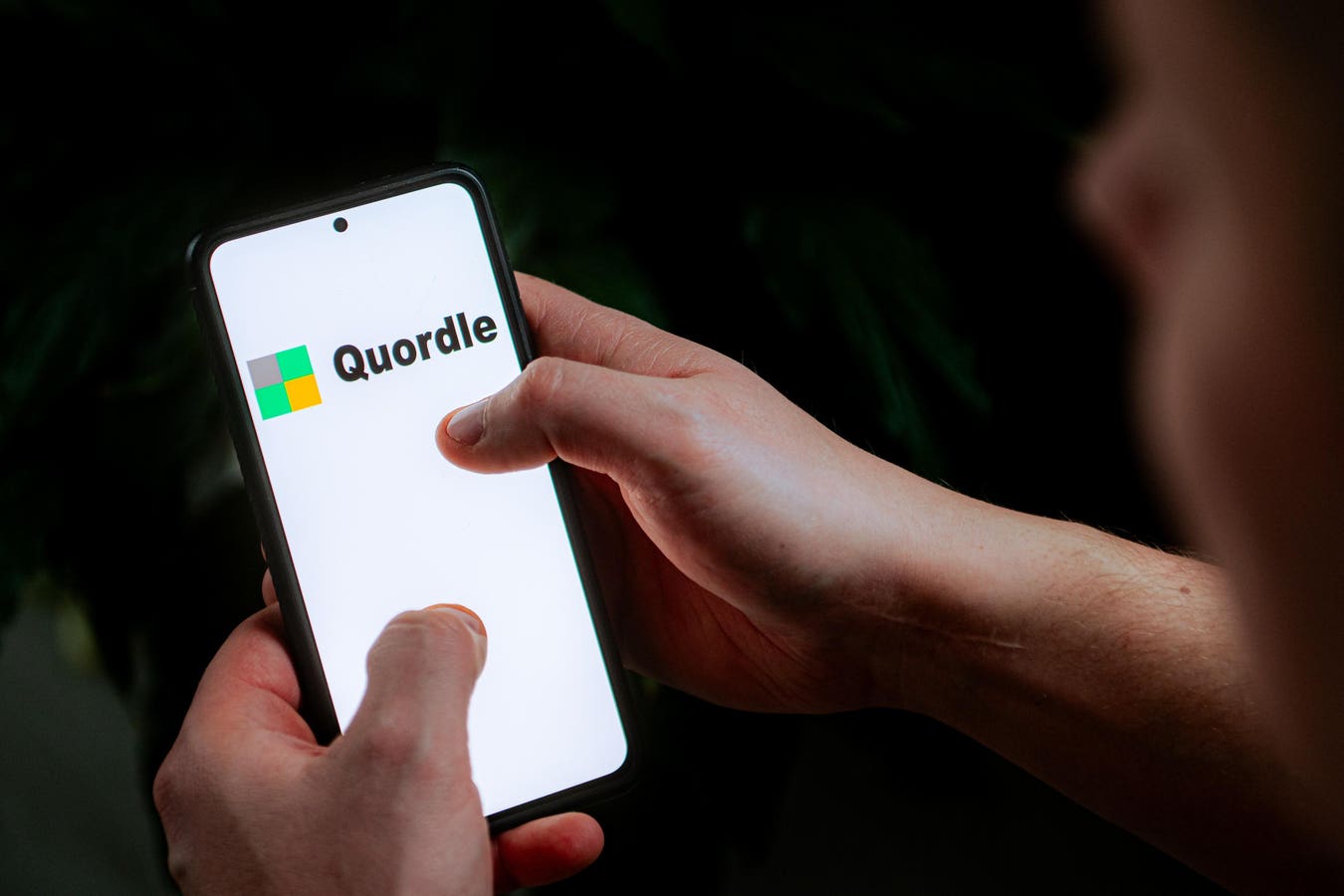BATH, UNITED KINGDOM – FEBRUARY 25: In this photo illustration a a 12-year-old school boy looks at a iPhone screen on February 25, 2024 in Bath, England. This week the UK government issued new guidance backing headteachers in prohibiting the use of mobile phones throughout the school day, including at break times. Many schools around the country are already prohibiting mobile phone use over concerns. The amount of time children spend on screens each day rocketed during the Covid pandemic by more than 50 per cent, the equivalent of an extra hour and twenty minutes. Researchers say that unmoderated screen time can have long-lasting effects on a child’s mental and physical health. Recently TikTok announced that every account belonging to a user below age 18 have a 60-minute daily screen time limit automatically set. (Photo by Matt Cardy/Getty Images)
Getty Images
Across the globe, governments are rethinking how smartphones fit into students’ daily lives. Brazil has enacted the world’s first federal school phone ban, while more than 35 U.S. states have introduced similar restrictions and other countries, such as South Korea, are about to do so. Beyond declining test scores and growing classroom distractions, the policies aim to address mental health risks for the young, with the U.S. Surgeon General comparing social media’s impact to cigarettes.
But what does actual research tell us about whether these policies work? From a cyberpsychology standpoint, smartphones are not just passive tools. They are constantly reshaping how we think, feel and relate to others. With that in mind, it is no exaggeration to note that the scenario for young people is concerning: a study by non-profit organization Common Sense found teens check their phones on an average of over 100 times per day and find it hard to stop using their devices.
Many smartphone bans in schools aim to mitigate the impact of unstructured use of devices and features such as social media notifications and text messaging. Research suggests that those unable to regulate their media use struggle with cognitive control, such as less control over their impulses and greater distractibility. This can in turn lead to poorer attention and working memory, which is the short-term memory needed to perform complex cognitive tasks and, ultimately, learn.
The Science Behind The Phone ‘Brain Drain’
The strongest evidence around the effects of smartphone use comes from controlled studies on cognitive impact. Smartphones consume working memory resources even when turned off and stored away, according to a 2017 study by University of Texas researcher Adrian Ward. His landmark study showed a 15% performance difference in cognitive tasks based solely on phone proximity, in what researchers now call the “brain drain” effect.
This happens because part of our mental resources are constantly devoted to not thinking about our phones, and that creates a form of cognitive load that impairs learning. Work published last year by researchers from the University of Augsburg confirms this pattern, finding phone restrictions produce academic improvements equivalent to adding one extra hour of instruction per week.
International evidence on smartphone bans in schools shows consistent but modest benefits on learning outcomes as well as other aspects. A study of 91 schools in England found a 6.4% increase in test scores after phone prohibitions, with effects persisting over time. Schools rolling out restrictions also report major decreases in behavioral referrals as well as increased face-to-face social interaction during breaks.
In Brazil, a pilot in Rio de Janeiro schools led by Stanford researchers showed the strongest effects of these measures globally, with a 25.7% improvement in mathematics and a 13.5% improvement in Portuguese grades.
A closer look at the types of student profiles such bans actually help sheds additional light on this debate. Low-achieving students in the England study improved test scores by 14% compared to 6% overall improvement, which suggests that bans are particularly helpful to students who struggle with self-regulation regarding phone use.
A Norwegian study tracking more than 400 schools found phone bans reduced girls’ visits to psychologists by 29% and also improved their grades, but the bans showed minimal effects for boys. Benefits seem to be strongest in middle schools, where impulse control is still developing, and in high-poverty schools, where phones may represent greater distraction from learning.
The Mental Health Paradox
Beyond mitigating the distractions smartphones offer, tackling mental health issues is another primary motivation for bans worldwide, but recent evidence on that front tells us this is a more complex and nuanced story. The most rigorous study to date, published in April in The Lancet Regional Health, found no significant differences in anxiety, depression or overall mental wellbeing between schools with restrictive versus permissive phone policies, even though students used phones 50 minutes less per day at restrictive schools.
This disconnect suggests that while devices can worsen mental health issues, just removing them doesn’t appear to solve more fundamental matters of anxiety, depression or social isolation that drive problematic phone use in the first place.
From a cyberpsychology perspective, smartphones trigger reward pathways in teenagers’ developing brains through intermittent reinforcement, which is the same mechanism that makes online gambling addictive. Manufacturers use persuasive design techniques, which aim to deliver instant gratification and stimulation. But that very design is problematic because it exploits adolescents’ vulnerabilities around social acceptance and forming identities.
On the other hand, used appropriately, smartphones at school can support education by making learning more efficient, practical and accessible. They can also support the development of digital literacy and promote collaboration, which in turn can enhance critical thinking and problem-solving skills.
Mobile devices can also be a lifeline for many students. Emergency contact with parents and accessibility features for disabled students are some of the important functions for devices at school.
As the debate continues with politicians, education professionals and parents arguing for and against restrictive measures around smartphones in the classroom without reaching consensus, a comprehensive review published last year analyzed 22 studies across 12 countries and concluded that the evidence for banning smartphones in schools is “weak and inconclusive.”
Global Experiments
There is no best practice when it comes to how a school should deal with smartphone restrictions, but there are concrete examples of different approaches around the world.
- France launched trials in 200 middle schools requiring students to completely surrender their phones, with early reports showing reduced cyber-harassment and increased social interaction.
- The Netherlands implemented restrictions gradually, starting with secondary schools. Teachers reported a 35% increase in student participation and pupils “talking to each other again.”
- Brazil’s comprehensive national ban affects all 48 million students in public and private schools, and it is the largest real-world test of phone restrictions to date.
While approaches vary and experiments are still in progress, efforts to understand the impacts of restricting phone use also reveal challenges. Most studies rely on natural experiments rather than controlled conditions, which makes it difficult to isolate the effects of phone policies from other factors. These natural experiments typically compare schools that have implemented phone bans with those that haven’t, but such schools often differ in other important ways (in aspects such as student demographics, administrative practices, or concurrent policy changes) making it hard to determine whether observed outcomes are actually caused by the phone policy or by these other variables. In addition, policies range from classroom-only restrictions to complete device surrender in locked pouches, making comparisons across studies difficult.
Smartphone bans at schools is a complex issue, and there is not yet a single answer to address it, considering the demands of a digitized society. However, future approaches should combine targeted restrictions with comprehensive digital wellness education. Phone-free periods during high cognitive demand activities like lectures and tests can counter “brain drain,” while maintaining access during breaks preserves the social and safety functions that smartphones serve.
Teaching students to understand how algorithms manipulate the content they see, the risks of cyberbullying and the need to develop self-regulation skills matters much more than simply banning devices. Especially since problematic phone use often reflects deeper issues of academic pressure, social vulnerability and family stress, which require comprehensive support.
As UNESCO’s global analysis on smartphone bans points out, students “should learn the risks and opportunities that come with technology and not be shielded from them.” So the goal should be helping young people develop healthy relationships with technology rather than trying to remove it from their lives.
The debate on smartphone use at schools ultimately reflects broader questions about attention, relationships and identity in the digital age. Phone bans can provide needed structure, but the real work involves teaching young people to navigate and regulate their digital engagement in a connected world. Research supports this nuanced approach: modest but real cognitive benefits for some students, particularly those most vulnerable to distraction, combined with the recognition that healthy digital citizenship requires education, not just restriction.









